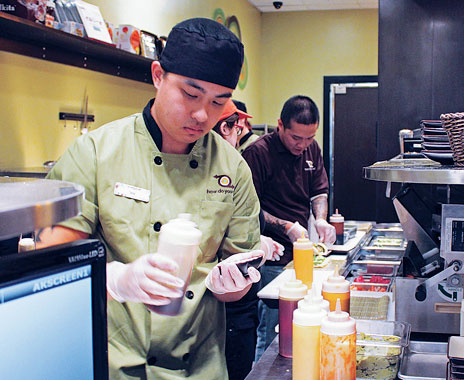It could happen to any restaurant.
Business is strong, with sales and unit counts growing quickly. Optimism abounds for a healthy future.
And then it happens. Contaminated food supplies filter into the system. Hundreds of customers get sick. Traffic and sales plunge as consumers worry over the food’s safety, and the brand’s reputation seems forever tarnished.
This scenario has played out in the restaurant industry several times, including among some prominent quick-serve companies. For many brands, the opportunity for fast growth outweighs the need to properly scale and safeguard food-safety standards, leading to disastrous results. While some companies have collapsed under such food-safety catastrophes, others have fought their way back to relevance and regained consumers’ trust.
Upstart companies in today’s limited-service environment, however, are working diligently to ensure they never have to face either scenario.
David Theno, head of Gray Dog Partners, a technical consulting business that specializes in food safety, food manufacturing, and supply-chain management, worked with a major restaurant brand to recover from a food-safety nightmare, and says it’s a “marvel” the company survived.
“Through a situation like this, you realize all the good work accumulated over the years can be undone in one day,” Theno says. “If folks really thought about food safety through that lens, I believe they’d pay more attention to it.”
As upstart concepts roll into new markets and begin scaling up, food safety becomes a more critical piece complicated by distance from one’s home base and the addition of new vendors. But in Theno’s eyes, food safety remains the one controllable, if often overlooked, metric that quick serves bet their business on each day.
“You can botch a marketing campaign, labor management, or cost controls, but none of those will shut you down tomorrow. A food-safety issue can and often does,” Theno says.
Beyond the business case, however, food safety is an important study in corporate responsibility. Jim Prevor, founder and editor of The Perishable Pundit, a forum that tracks the fresh foods industry, says restaurants can’t betray consumers’ trust that food will be fresh and safe.
“When you move into new markets, you’re losing that direct approach and need to switch to a systems approach that has standard operating procedures, training programs, and the like aligned toward food safety,” Prevor says. “All of that can be a real challenge.”
For emerging, ambitious quick serves, food safety poses tremendous risks. With a still-forming corporate backbone and with a need to build momentum to propel the brand’s ambitions, one food-safety incident can prove disastrous.
“Beyond our mission to have our guests’ confidence and to avoid harming anyone, we want to be able to fulfill the potential we see for ourselves as a brand, which will be a struggle to achieve if we mess up on food safety,” says Dan Ross, COO of How Do You Roll?, a six-year-old, Austin, Texas–based sushi concept growing from 10 to 30 units this year while moving into five new states.
In the coming years, many food-safety insiders believe, advancements in disease surveillance will bring more issues to the public’s attention. Existing pathogens could appear on items to which they have not previously been linked, while new pathogens could emerge as well.
“As the food system gets smarter at identifying bugs and tracing, there’s the potential for even more food-safety issues to surface,” says Robert Hibbert, who specializes in federal regulations in the food and agricultural industries as a partner in the Food and Drug Administration (FDA) and Healthcare practice at Morgan Lewis.
In the quick-service world, one in which restaurants can become sources of widespread germ transmission, food-safety problems are almost always the function of supply-chain missteps or in-store ignorance, such as shoddy protocols for product storage, rotating items, or employee hygiene. But experts say that before any quick-service concepts can begin installing procedures or taking vendors to task, there’s often a first, more important, step operators must take: acknowledging the importance of food safety and weaving its significance into the company’s culture in a meaningful way. Developing the right food-safety culture early on, many agree, is one of the best ways to avoid food-safety troubles that can be caused by growth.
“[Food safety] needs to be more than items checked off on a list, but something management and rank-and-file staff believe in,” Hibbert says.
An esoteric topic, food safety can easily fall into the background, fading behind more tantalizing topics like menu development, marketing, and store design. Theno, however, says food safety demands attention and he urges quick-service leaders to integrate food-safety practices into their daily operations so it becomes top of mind.
“There needs to be an active food-safety management system and people held accountable to it,” Theno says, suggesting operators use daily logs or third-party audits as measurable metrics.
Prevor knows of one national full-service concept that began tying its management bonuses to third-party food safety audits. As a result, compliance increased. “You want to create a system that isn’t based on profits alone,” he says.
To take the issue seriously, Theno says, store management must execute thorough training programs on food safety, demanding workers take the necessary precautions and never pressuring sick employees to work.
For emerging brands in particular, Theno and Prevor both urge brand leadership to begin developing well-rounded internal food-safety teams and a food-safety infrastructure that anticipates the concept’s growth. This includes having people throughout the organization be ServSafe certified through the National Restaurant Association.
“It’s much better to develop systems and processes when you’re small,” Theno says. “If you get too big, integrating such things can become difficult to retrofit because there are more people involved and stores are further apart. Do it right today and it’s easier down the line.”
The proactive, culture-building approach is exactly the philosophy being embraced by Garbanzo Mediterranean Grill, a seven-year-old fast-casual concept approaching 30 units across nine states. The Colorado-based company requires that every key-holding manager earn ServSafe certification, and Garbanzo regional training manager Stephanie Swickard, herself carrying the ServSafe credential, conducts formal ServSafe classes with Garbanzo managers three times each year.
In addition, Garbanzo voluntarily developed a Hazard Analysis & Critical Control Points program, a management system addressing food safety through the analysis and control of certain hazards from raw materials. The company also has an independent third party visit its restaurants twice each year to conduct food-safety evaluations.
[pagebreak]
“We have opted for these customized, on-site audits to provide an additional food-safety checkpoint,” Swickard says. “[The third-party agency’s] standards are sometimes stricter than the state-mandated standards, which makes us feel even more confident in our food-safety practices.”
When a quick serve understands the value of a comprehensive, 360-degree food-safety plan, it’s often an easier path to installing in-store procedures and supply-chain requirements.
Hibbert says restaurants should have written guidelines followed religiously by staff and monitored by management. Even more, those food-safety policies should be designed for stores across the system.
In line with Hibbert’s point, How Do You Roll?—which, as a sushi concept, deals with raw seafood products—maintains system-wide protocols for checking in product, defrosting items, monitoring shelf life, and conducting similar food handling activities. Stores also have standard labeling protocols that allow any team member to know when a given item was prepared and when it expires.
“This is the only way to make brand standards remain consistent,” Ross says.
At Garbanzo’s restaurants, staff avoids cross contamination by prepping the restaurant’s vegetables prior to opening. Preparing and marinating proteins is left for the end of the day, when all produce is in storage. The fast-growing Mediterranean chain is also playing to food allergies, an increasing consumer issue, with policies around changing gloves as well as using fresh utensils and food containers, Swickard says.
For any restaurant chain, a credible third-party audit can provide tangible feedback on the unit’s standard operating procedures and areas for improvement.
“With food safety, it’s about translating the simple things into a format that people can actually manage,” Theno says.
On the supply-chain side, growing brands can face a significant struggle as they enter new markets, increase their unit count, and integrate new vendors. For these brands, Prevor champions firm requirements for new vendors, assessing any candidate’s storage and distribution, and factoring food safety into the criteria on which any prospective vendor will be judged.
“This can’t just be about getting the lowest bid,” Prevor says.
While grocery chains that are facing a food-safety challenge can, and often do, pin the problem on a particular vendor and simply move a substitute product onto the shelf, restaurants cannot take such cover. As a result, restaurants need to be extra vigilant with supply-chain partners.
“If something blows up, that vendor has other customers, but what happens to you?” Theno asks.
That precise recognition has spurred leaders at How Do You Roll? and Garbanzo to take substantial steps to vet vendors. As Garbanzo imports some items from the Mediterranean region, CEO Alon Mor personally visits the company’s overseas vendors to verify that the products meet Garbanzo’s quality and safety guidelines. At How Do You Roll?, Ross says, the company has placed great emphasis on understanding vendor protocol, which provides the company confidence in the seafood’s path from catch into its kitchens.
Given the farm-to-fork ideology that has swept the restaurant industry in recent years, supply-chain standards today have added importance with fresh produce. Unlike proteins such as meat and chicken, produce has no built-in kill step to destroy pathogens.
With nearly 60 percent of its food purchases being produce, Garbanzo has incorporated systems through its distributors to track produce, trace issues back to the grower, and activate a recall plan as necessary.
Since walking a vendor’s tomato fields is not a realistic venture for many quick-service leaders, even those prioritizing food safety, Prevor says, one potential solution for smaller brands might be to establish contacts with the suppliers of well-known national names like McDonald’s, Disney, Darden, and others with high-quality food-safety programs.
“Piggyback off of them,” Prevor says. “These companies have tremendous reputational risk and are more than likely getting the safest products that can be obtained.”
Another shrewd move would be monitoring proposed regulations from the FDA, Hibbert says. By getting ahead of the regulatory structure, restaurants can seek out vendors who already fall in line, or compel existing suppliers to improve their processes.
“If you understand where the FDA is trying to go, then you can take a hard look at your operation and address the necessary areas,” Hibbert says, adding that savvy operators will also review specific target areas and local and state food-safety requirements.
“It’s simply smart business for restaurants to understand any special characteristics in a particular jurisdiction,” Hibbert says.
Theno is intimately aware of the turmoil and tragedy food-safety negligence can trigger. He urges restaurant operators big and small to reflect on their food-safety programs, as well as their individual responsibilities to safeguard guest health.
“Are you doing all that you can and should to protect the guests that walk through your doors?” Theno asks.







